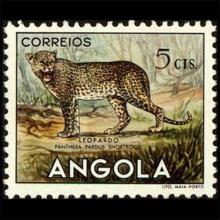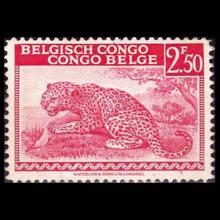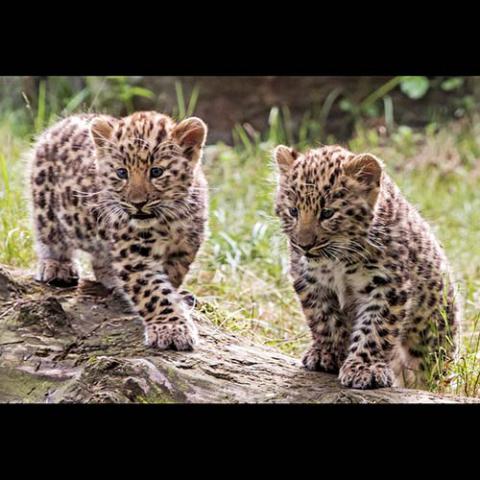NAMES
TAXONOMY
South Africa
Issued:
Stamp:
Panthera pardus
Angola
Issued:
Stamp:
Panthera pardus
Belgian Congo
Issued:
Stamp:
Panthera pardus
South Africa
Issued:
Stamp:
Panthera pardus
Angola
Issued:
Stamp:
Panthera pardus
Belgian Congo
Issued:
Stamp:
Panthera pardus
South Africa
Issued:
Stamp:
Panthera pardus
Angola
Issued:
Stamp:
Panthera pardus
Belgian Congo
Issued:
Stamp:
Panthera pardus
Genus species (Animalia): Panthera pardus
The leopard (Panthera pardus) is one of the five extant species in the genus Panthera, a member of the cat family, Felidae. It occurs in a wide range in sub-Saharan Africa, in some parts of Western and Central Asia, Southern Russia, and on the Indian subcontinent to Southeast and East Asia. It is listed as Vulnerable on the IUCN Red List because leopard populations are threatened by habitat loss and fragmentation, and are declining in large parts of the global range. The leopard is considered locally extinct in Hong Kong, Singapore, South Korea, Jordan, Morocco, Togo, the United Arab Emirates, Uzbekistan, Lebanon, Mauritania, Kuwait, Syria, Libya, Tunisia and most likely in North Korea, Gambia, Laos, Lesotho, Tajikistan, Vietnam and Israel.[3] Contemporary records suggest that the leopard occurs in only 25% of its historical global range.
Compared to other wild cats, the leopard has relatively short legs and a long body with a large skull. Its fur is marked with rosettes. It is similar in appearance to the jaguar (Panthera onca), but has a smaller, lighter physique, and its rosettes are generally smaller, more densely packed and without central spots. Both leopards and jaguars that are melanistic are known as black panthers. The leopard is distinguished by its well-camouflaged fur, opportunistic hunting behavior, broad diet, strength, and its ability to adapt to a variety of habitats ranging from rainforest to steppe, including arid and montane areas. It can run at speeds of up to 58 km/h (36 mph).[7] The earliest known leopard fossils excavated in Europe are estimated 600,000 years old, dating to the late Early Pleistocene. Leopard fossils were also found in Japan[8] and Sumatra.
Etymology
The English name 'leopard' comes from Old French: leupart or Middle French: liepart, that derives from Latin: leopardus and Ancient Greek: λέοπάρδος (leopardos). Leopardos could be a compound of λέων (leōn), meaning lion, and πάρδος (pardos), meaning spotted. The word λέοπάρδος originally referred to a cheetah (Acinonyx jubatus).
'Panther' is another common name, derived from Latin: panther and Ancient Greek: πάνθηρ (pánthēr); The generic name Panthera originates in Latin: panthera, which refers to a hunting net for catching wild beasts that were used by the Romans in combats. The phonetically similar Sanskrit: पाण्डर (pând-ara) means pale yellow, whitish or white. The specific name Latin: pardus refers to a male panther. The word pardus is thought to originate from Ancient Greek: παρδάλωτός (pardalotόs) meaning spotted like a leopard.
Reference: Wikipedia
Photo: Wikipedia, Taiwan News





